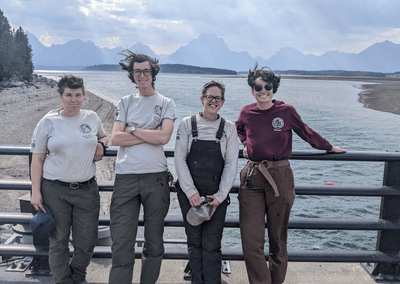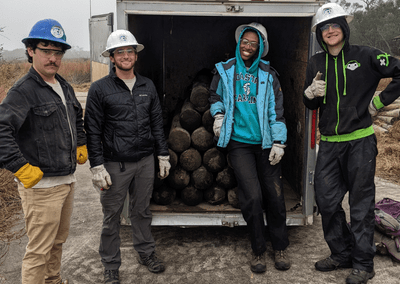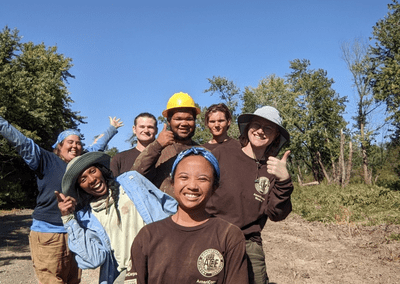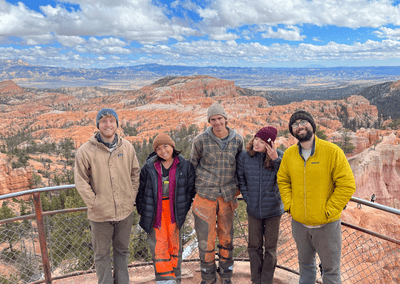ACE Conservation Crew
Join a Conservation Crew
American Conservation Experience’s Conservation Crew program provides a hands-on, experiential opportunity like no other!
As part of a crew, you’ll join a team of individuals who want to make a difference, learn more about conservation, as well as those who are launching their conservation career.
Conservation corps are part of AmeriCorps and positions are open to individuals ages 18-30 and up to age 35 for veterans.
Members benefit from gaining essential field and professional development skills while building lifelong friendships. By working alongside ACE staff and representatives from the National Park Service, US Forest Service, Bureau of Land Management, US Fish and Wildlife Service, and other leading agencies, members gain invaluable career perspectives and mentorship in a variety of areas.
Crew members may apply for 3, 6, 9 month or longer terms, with opportunities for extensions, as well as possibilities to move up in the program to become Assistant Leaders or staff as Crew Leaders, Project Managers, and beyond. We have hub sites across the US – visit our Locations Page to learn more.
Why Crew?
- Gain conservation work experience
- Housing provided in most locations
- Work with staff from local and federal land management agencies
- Food and transportation while on project
- Living allowance
- AmeriCorps Education Award upon successful term completion
- Some positions are eligible for PLC noncompetitive hiring authority
- Hands-on field projects and trainings
- Opportunities for professional development trainings
- Opportunities to travel regionally for projects as well as off days
What are you waiting for? Apply today!
See below to learn about the types of projects.
Watch our video to hear from crew members as they work on projects in the Grand Canyon and Organ Pipe Cactus National Monument.
ACE was a huge step for me towards empowerment, learning invaluable skills, fulfilling my dream of travel, and what led me to take the job I currently hold.
Crew Project Areas
ACE Conservation Crews often work on a variety of projects, depending on location and season. Members typically have the opportunity to gain technical experience in multiple areas of conservation corps work throughout their term.
Trail Maintenance and Construction
Members that work on trail maintenance and construction can expect to learn hands-on skills for the implementation of sustainable trail design for varying use and weather conditions. From benching in new tread and laying out trail reroutes to installing erosion control structures and brushing corridors, ACE crews are instrumental in maintaining public use trails across the U.S. while minimizing impact and protecting surrounding habitat. Crews use tools such as the pick-mattock, McLeod, shovels, hand saws, loppers, and more to shape and improve trails, further preparing members for future careers and lifelong stewardship of public lands.
Rock work serves as a special aspect of trail work and is often connected to long-term durability against heavy use and climate impacts. Corps jobs performing rock work may install erosion prevention features such as check dams, steps, or armoring, along with larger structures such as staircases or multi-tier retaining walls. Specific projects may allow members to engage with the grip hoist apparatus, used for safely maneuvering sizable boulders onto or off of the trail. Members on rock work projects can expect to use tools such as rock bars, single and double jacks, masonry hammers, chisels, and feathers and wedges, along with the occasional drill or pionjar to assist in creating lasting trail structures.
Fencing Construction
Projects involving fencing construction or maintenance may assist public land agencies in a number of ways, from marking a land boundary, assisting in surveying efforts, or preserving a site from unauthorized use. Members working on fencing projects can expect to learn about installing wood or metal braces, T-posts, and wire, as well as how to select appropriate materials to allow for safe movement of local wildlife. Using tools such as post pounders, wire stretchers, and fencing pliers (often called “babies” on Crew, as you would hate to lose or neglect them!), members work as a close team to communicate across wide distances in order to achieve proper wire tension and safety complete a section of fence.
Forest Thinning and Fuels Reduction
Forest thinning projects are an essential part of ACE’s contributions to nationwide (USA) conservation work and fire mitigation efforts. Historically, many forests were allowed to burn regularly, preventing areas from becoming overgrown, while encouraging propagation of fire-resistant species. However, due to fire suppression over the last century, combined with current climate crises and extreme weather events, forests are becoming increasingly susceptible to broad scale devastation, with lasting impacts on human and wildlife communities. During a service term, members may have the opportunity to gain training and skills in chainsaw or crosscut saw operation, along with a Wilderness First Aid (WFA) certification. Members working on forest thinning or fuels reduction projects can expect to mark, fell, buck, and pile or remove designated trees or logs from overgrown, fire-suppressed areas in order to help restore forests to historic conditions.
Habitat Restoration
ACE Crews working on habitat restoration efforts may perform a wide variety of tasks such as planting, naturalizing social trails (unauthorized walking or vehicle paths), or selectively spraying herbicide, among others. Members involved in habitat restoration projects can expect to learn plant identification of local plant species, as well as how to safely use and maintain gear. Planting projects may involve the use of power augers or dibble bars, while naturalization of social trails can typically be accomplished with trail tools. On herbicide projects, crews typically use backpack or hand sprayers and additional personal protective equipment (PPE) to eradicate invasive species via foliar, cut-stump, or basal treatments. Herbicide treatments may be selected in place of hand-pulling or mechanical removal due to a site’s sensitivity or historical significance, or due to an invasive species’ robust ability to quickly outcompete or harm others in the ecosystem.
Invasive Species Removal
Members working on invasive species removal projects can expect to participate in a variety of tasks depending on location, conditions, and designated species. While some invasive removal efforts do include herbicide as part of habitat restoration, ACE crews may also use hand tools, chainsaws, brushcutters, and hand-pulling to mitigate species spread. Members may attend to invasive Russian olive, Chinese tallow, Brazilian peppertree, kochia, thistles, and many more in their local region. Some efforts involve removal of seed heads to prevent propagation, while others call for surface treatment or uprooting of the whole stem. Invasive species removal typically requires consecutive intervention efforts for lasting results.
Facilities Maintenance
ACE Crews work with local and federal public land agencies to maintain high-use areas as part of conservation efforts to encourage visitors to minimize impact through use of designated facilities. Members working on public land projects can expect to assist in these efforts through site stewardship tasks such as removal of litter or camp debris, dismantling of unauthorized fire rings, and cyclical maintenance of walkways, erosion control structures, and more. For those interested in park or site management, facilities and recreation maintenance can provide an opportunity to understand daily operations and preparation for busy visitor seasons.
Historic Preservation
Historic preservation projects can vary widely depending on location and site needs but may include aspects of other project areas such as rock work, invasive species removal, trail maintenance, and habitat restoration. ACE Crews have previously worked on or near historic sites to provide ADA-accessible pathways, reconstruct battlefield rock walls, maintain cliff dwellings, restore historic cabins, and much more. Members who participate in historic preservation projects can expect to find unique experiences and skill sets in connection to their region’s history, along with opportunities to speak with and ask questions of local experts within their partnering agency.
Wildlife Surveying & Monitoring
ACE Crew projects focused on wildlife surveying and monitoring work within a variety of ecosystems to assist land agency staff in collecting data and observing local species. ACE Crews typically assist with desert tortoise monitoring and large scale fish monitoring efforts across the U.S., along with sea turtle nesting protection and release. Other project areas such as habitat restoration often converge with wildlife monitoring through maintaining a species’ natural habitat and preventing harm from visitors or unauthorized off-highway vehicles (OHVs). Outside of specific wildlife survey projects, members have the opportunity to learn about local flora and fauna on nearly every project, as well as how to respect wildlife in the field and maintain a safe distance.
What is the Conservation Corps?
Locally based organizations, like American Conservation Experience (ACE), called corps work with young people and veterans on public service projects that address needs in the areas of recreation, protecting land, conservation, cultural resources, disaster relief, and the community.
Participants in the corps, often known as “Corpsmembers,” gain hands-on experience and build marketable, transferrable skills throughout a term of duty that might range from a few months to a year.
After completing their service, corps volunteers often receive an academic grant or scholarship in addition to their salary or living allowance.
Furthermore, many corps offer its members mentorship, educational programs, and access to personal and professional counseling. To assist members in obtaining their GED or high school graduation, several corps run charter schools or collaborate with them.
Conservation Corps Age Requirement & Limit
While ages vary within ACE’s conservation corps’ programs, most require a minimum age of 18 and a max age of 30, with an exception for military veterans, who can often serve up to the age of 35. Most conservation corps are funded by federal dollars that are earmarked for youth programs.
About the Segal AmeriCorps Education Award
This award is commensurate with the chosen term of service. Education awards can be used post-term for expenses such as tuition, student loans or fees, and a breadth of study or certification courses, including many offered by NOLS (National Outdoor Leadership School).



